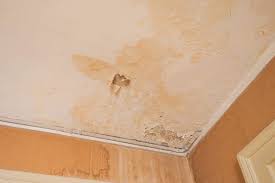There are few feelings worse than being confronted with water damage. If you have a ceiling that’s water stained, peeling and or cracked, here’s what to do. There are few feelings worse than being confronted with water damage. If you have a ceiling that’s water stained, peeling and or cracked, here’s what to do.
Stabilize the Situation
The first step is to stabilize the area around the leak. Move valuables out of the area and then break out a bucket and tarp to catch and contain any water that’s built up behind the ceiling. Chances are your ceiling covering is drywall, which will absorb or disperse the water. You’re better off controlling where water comes through the ceiling. Do this by creating a small hole at the center of the leak using an awl, screwdriver, or similar object, so that the water will pass though that controlled opening and into your bucket.
Track Down and Repair
Next, it’s time to track down and repair the source. Water can travel a surprising distance from the initial leak, and roof leaks in particular can be tough to isolate. Even in an apparently simple situation, such as when a bathroom is directly above the stain, there are still a number of potential sources for the water. It could be a leaking drain, loose supply line, or missing caulk.
You may need to cut a hole in the ceiling in order to see where the water is coming from, and if you’re having trouble re-creating the leak, you might try the old trick of laying sheets toilet paper along pipes and ceiling joists. The toilet paper will clearly show any reaction to moisture, allowing you to narrow the scope of your search.
Dry the Damage
While repairing the source of the leak, allow any affected materials to thoroughly dry. This is especially true of the ceiling cavity because moisture trapped behind the drywall will be prone to developing mold. A minor leak may dry up on its own, but, for larger leaks, it’s often best to open up a section of the ceiling and air it out with the aid of a fan.
Repair the Ceiling
Depending on the leak, this may involve simply touching up with a bit of Spackle and paint, or it might mean replacing and repainting the entire ceiling. Keep in mind that it’s often easier to simply remove damaged drywall back to dry material. This often exposes ceiling joists, which makes hanging patches easier. The same goes for painting, as it’s often easier to feather new paint into a larger area, or even paint the whole ceiling, in the case of a larger leak.

